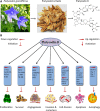Killing cancer with platycodin D through multiple mechanisms
- PMID: 26648178
- PMCID: PMC4759477
- DOI: 10.1111/jcmm.12749
Killing cancer with platycodin D through multiple mechanisms
Abstract
Cancer is a multi-faceted disease comprised of a combination of genetic, epigenetic, metabolic and signalling aberrations which severely disrupt the normal homoeostasis of cell growth and death. Rational developments of highly selective drugs which specifically block only one of the signalling pathways have been associated with limited therapeutic success. Multi-targeted prevention of cancer has emerged as a new paradigm for effective anti-cancer treatment. Platycodin D, a triterpenoid saponin, is one the major active components of the roots of Platycodon grandiflorum and possesses multiple biological and pharmacological properties including, anti-nociceptive, anti-atherosclerosis, antiviral, anti-inflammatory, anti-obesity, immunoregulatory, hepatoprotective and anti-tumour activities. Recently, the anti-cancer activity of platycodin D has been extensively studied. The purpose of this review was to give our perspectives on the current status of platycodin D and discuss its anti-cancer activity and molecular mechanisms which may help the further design and conduct of pre-clinical and clinical trials to develop it successfully into a potential lead drug for oncological therapy. Platycodin D has been shown to fight cancer by inducing apoptosis, cell cycle arrest, and autophagy and inhibiting angiogenesis, invasion and metastasis by targeting multiple signalling pathways which are frequently deregulated in cancers suggesting that this multi-target activity rather than a single effect may play an important role in developing platycodin D into potential anti-cancer drug.
Keywords: apoptosis; autophagy; invasion; metastasis; platycodin D; saponin.
© 2015 The Authors. Journal of Cellular and Molecular Medicine published by John Wiley & Sons Ltd and Foundation for Cellular and Molecular Medicine.
Figures




References
-
- Ferlay J, Soerjomataram I, Dikshit R, et al Cancer incidence and mortality worldwide: sources, methods and major patterns in GLOBOCAN 2012. Int J Cancer. 2015; 136: E359–86. - PubMed
-
- Millimouno FM, Dong J, Yang L, et al Targeting apoptosis pathways in cancer and perspectives with natural compounds from mother nature. Cancer Prev Res. 2014; 7: 1081–107. - PubMed
Publication types
MeSH terms
Substances
LinkOut - more resources
Full Text Sources
Other Literature Sources

